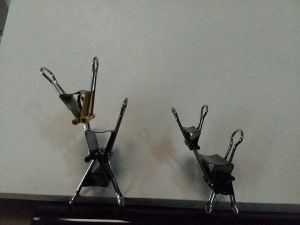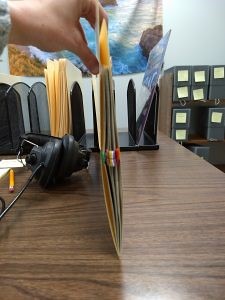by Lara Canner, Allan Blank Curator of Music Special Collections
Last year, my brilliant co-worker created animal sculptures made from binder clips.
The binder clips used in the sculpture were originally part of an already processed acquisition. After reviewing the collection, the clips were found to be causing harm. Once a helpful tool to separate paperwork in folder, now the binder clips needed to be removed due to tearing, creasing and potential for rust stains. That got me thinking about archival best practices, how processing has changed over time and how even good intentions can harm collections in the long run. I absolutely hate paperclips. Paperclips rust to paper causing staining and can create tears when removed. Ugh
Yet, the archival alternative, clips made of plastic, can cause damage too, if not used properly.
Archival grade plastic clips will not rust, tear paper and come in an assortment of fun colors…they are the superheroes of the paperclip world! However, problems occur when archival processors rely on too much on the clips for separation. Okay…what does that mean?
So, the very basic definition of a paper clip is to both keep paperwork connected and also keep that paperwork separated from other materials. This reasoning becomes tremendously important in the archival theory of original order. At the same time, the processor wants to keep the collection formulated the way the contributor first had the papers organized, but in a way accessible for researchers. Thus, plastic clips become a way to at once keep original order yet maintain separation for general clarity.
An example of this is found in the Allan Blank collection. In my most recent processing, I discovered sketches for a Trio (Clarinet, Flugelhorn and Piano) all in the same box, but separated by other sketches, scores and reference materials. I could keep all of these sketches separate based upon the original order, but it would be much easy on a researcher if the sketches were altogether. However, if I were to use plastic clips, I could maintain original order and still have ease of access. Great! Problem solved! Yeah…not really. Okay…why are plastic clips bad if too many are utilized?
Now, in archival ancient times, it would have been fine to put a bunch of paperclips on the materials and call it good, but best practices have changed. Lots of plastic clips separating paperwork while a seemingly innocent way to keep order, can actually cause harm.
I prefer the method of clear organization within series and sub-series. Researchers can easily access materials using a clear finding aid, while the papers maintain original order within the folders. Over the course of processing, I have used approximately two plastic clips. Adhering an envelope to letter and for keeping a small note to a score.
In the end, archival processing theory is an evolving process. New products are introduced that help keep records safe, but archivists still need to be careful when protecting documents. Plastic clips are definitely an archivist’s friend!



